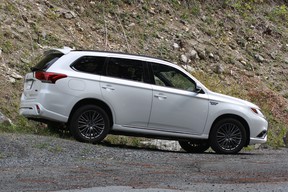Long-term test introduction: 2022 Outlander PHEV Black Edition
It doesn't take much seat time to understand why this SUV is the top selling plug-in hybrid in Canada

Article content
It took all of about a half a day into my long-term test of the Outlander PHEV to understand why it is the country’s top-selling plug-in hybrid. Now that I’ve had a couple of weeks using the all-wheel-drive SUV for all manner of things on all manner of roads, my appreciation for it has only grown.
Advertisement
Article content
Sure, there are a few niggling things that I discovered over time — the seemingly random placement of drive mode buttons, the absence of a built-in NAV system — but in terms of being a comfortable, practical and, if managed properly, downright frugal compact crossover, the Outlander PHEV passes with flying colours. And with an all-in price under $50,000 for my tester, before rebates at that, it’s a very strong value for money proposition too. As to those rebates, there is the $2,500 federal one, and provincial ones in B.C. ($1,500), Quebec ($4,000), New Brunswick ($2,500), Nova Scotia ($2,500) and PEI ($2,500).
This model is the last of its generation, with an all-new plug-in Outlander coming next year as a 2023 model, promising more power and more all-electric range. It will also, no doubt, come with a new body style, one most likely similar to its fourth-gen, gas-powered stablemate. Increased engine output and range are most welcome; however, I’m not convinced the ‘new’ look — including somewhat demonstrative headlights — is an improvement over the current PHEV’s sleek and smooth exterior.
Advertisement
Article content
That improvement to the power output of the Outlander PHEV continues what has been a steady march in that direction, as the 2021 model received a bigger engine — a 2.4-litre in place of the 2.0-litre — larger battery capacity — from 12 kWh to 13.8 kWh — and upgraded electric motors over the previous plug-in. That’s the same powertrain that is in my tester, with that four-cylinder putting out 126 horsepower and 149 lbs.-ft of torque. Dial in that electric power, however, and the combined power output is 221 hp, or 31 hp over the previous powertrain. And the electric range bumped up from 35 km to 39 km (but on that note, my first couple of weeks have seen a higher all-electric range. More on that in the second instalment of this long-term test drive in a couple of weeks).
Advertisement
Article content
Also new for 2021 are Sport and Snow driving modes integrated into Mitsubishi’s tried-and-true Super All-Wheel Control (S-AWC) all-wheel drive system. To engage these modes you simply press the Twin-Motor 4WD LOCK button to simulate locking of a centre differential and optimally distribute torque to all four wheels to maximize traction.
What makes the Outlander PHEV stand out among most of its plug-in peers is the ability to use Fast Charging to juice up the battery pack, which takes about 25 minutes to replenish up to 80 per cent power. Other charging methods include using a standard outlet at home with a supplied charging cable, through brake regeneration, and through ‘Charge Mode’ which uses the gasoline engine to charge the battery (I’ll also report more on this latter system in the next instalment).
Advertisement
Article content

What I’ve come to appreciate about the Outlander PHEV is that there is a lot going on with that powertrain, depending on which drive mode you are in, how you drive when in EV mode, and even how you use the five-level regen braking paddle shifters on the steering wheel. And the full-charge range has gone as high as 91 km, which I’m still trying to figure out. For all of that, I’m glad to have this vehicle longer than the typical week we get to test a new car out.
However, my two weeks so far have revealed a few things about the Outlander PHEV. Most notably, how little gas I’ve used during my daily commute and errands. I’ve plugged it in every night in my car port, and by morning have a full charge. The rare occasions when I’ve gone further than 50 kilometres are the only times the gas engine has fired up. I made it from my home in North Vancouver to the Vancouver airport and back on electricity only — a round trip of 58 kilometres — with more than handful of clicks on the clock. I also did some off-road travel in the Outlander PHEV along some logging roads near Squamish, and the all-wheel-drive system performed as advertised — my only complaint being the gas-engined power output was not ideal for climbing up some of the steeper sections. However, the vehicle’s low centre of gravity — greatly aided by the battery pack — kept it pinned and stable to the ground, and provided a fairly high level of 4×4 confidence.
Advertisement
Article content

In the coming weeks I hope to fill it up with passengers for some urban exploring, take my dog for some mountain hikes and dive deeper into the inner workers of that mysterious gas-electric powertrain.
One final thing: on three occasions now I have been approached by Outlander PHEV owners in parking lots and on side streets asking me all kinds of questions. How long have I owned it? Did I have the previous generation model before this one? What’s the highest I’ve got the all-electric range to on the gauge? How much range do I think the next gen will have?
Passionate is an understatement in describing their appreciation for the model, and to me that is a ringing endorsement of this vehicle. Needless to say, I’m looking forward to the next few weeks testing it out more.





